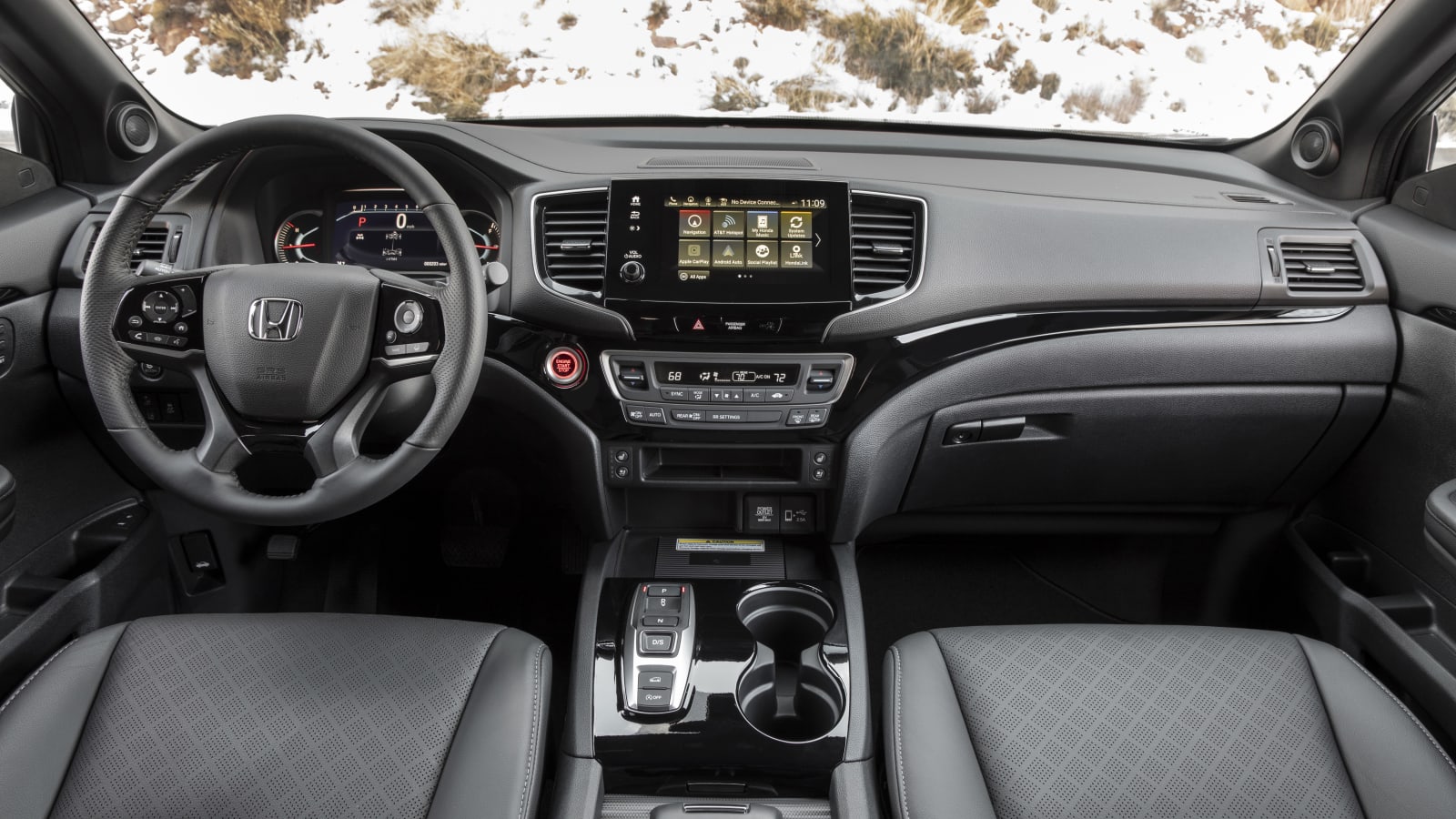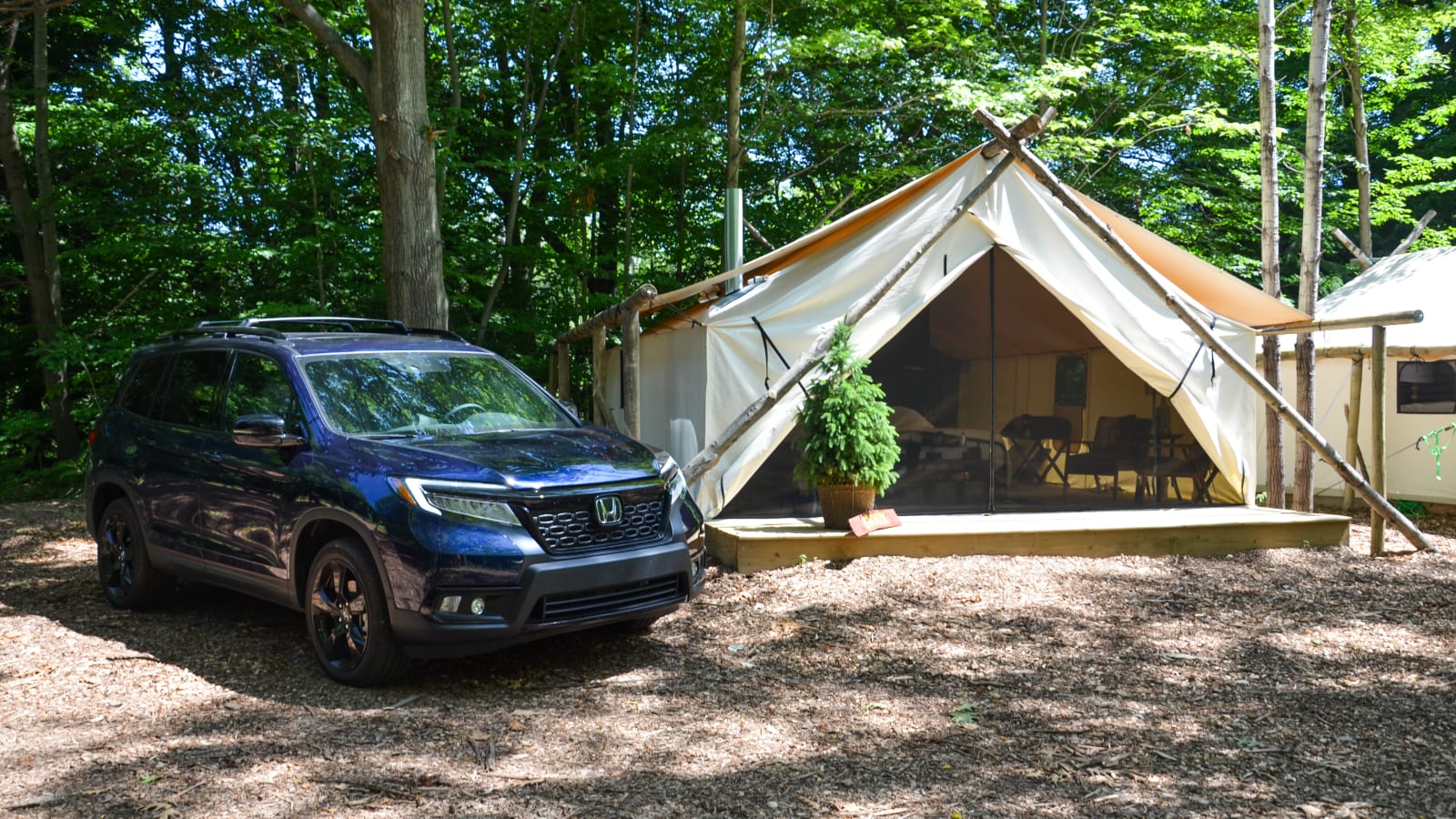The 2021 Honda Passport is quite obviously a Pilot that has had some inches and a row of seats lopped off its tail. Sure, it has a different grille, big black wheels, chunkier roof rails and extra ground clearance, but the similarities are impossible to miss. The interior design is literally identical.
So why bother considering this midsize SUV with three fewer seats? Well, you wouldn’t be alone in pondering that considering the Passport sells in far fewer numbers than the Pilot does. However, we think that it generally makes sense. The Passport is roughly $2,000 less than a comparable Pilot (the base prices are nearly equal, but the Passport includes more equipment), and if you’re unlikely to use that extra seating row, why bother lugging it around? The Passport still has a colossal amount of space in its second row and cargo area, while its smaller size improves its acceleration and sharpens its driving experience. We also think there’s value in its quasi-rugged attributes, including its 8.1 inches of ground clearance and more functional roof rails. It’s basically a Toyota 4Runner for those willing to sacrifice extreme capability for better efficiency and on-road handling. And, of course, being OK with the Pilot-in-hiking-boots look.
What’s new for 2021?
The base Passport Sport gains the 8-inch touchscreen and standard Apple CarPlay and Android Auto found on every other trim level. That’s it. We suspect the Passport will receive a full redesign soon, but it probably wouldn’t happen until after the next-generation Pilot debuts, likely for 2022.

What’s the Passport interior and in-car technology like?
If you’re trying to choose between Passport and Pilot, the interior design won’t be of any help: they are identical. That’s not necessarily a bad thing. Both share a common look that’s clean and functional, but hardly as visually interesting as what you’d find in a Chevy Blazer or Hyundai Santa Fe. Material quality is very strong for this segment and everything is put together exceedingly well.
Also shared with the Pilot is the exceptional interior storage. There are multiple door bins, two cupholders in each rear door, two areas to store a smartphone up front, and the giant center bin is big enough to hide a purse under its flat rolling cover. There’s even more storage underneath the cargo floor, including a plastic bin that can be easily cleaned and drained.
Interior tech is less impressive. There is a lot of it standard, true, but the means in which it is controlled can frustrate. There are insufficient menu buttons, no tuning knob and/or direct tune function, and the process for going between Honda and Apple/Android interfaces is excessively annoying. Many of these issues were corrected for the vastly improved system in the Accord and Odyssey, but the Pilot/Passport/Ridgeline family soldier on with ye olde interface. If there’s a reason to ponder something other than the Passport, this would certainly be it.

How big is the Passport?
For a midsize two-row crossover, the Passport provides an enormous, space-efficient interior. Only the Volkswagen Atlas Cross Sport comes close to its passenger and cargo space. The second row offers abundant head- and legroom, while also sliding considerably to bring kids closer to parents up front or to free up cargo space. Need to fit a rear-facing child seat? No problem. There’s more than enough space between rows and lower LATCH anchors for all three positions.
The cargo area is not only the biggest in the segment, but arguably the most versatile as well. Besides expanding thanks to the sliding back seat, it also houses a large bin under the floor that can hide valuables or secure dirty items from the clean interior (it can also be removed to be cleaned). The cargo area itself is deep, wide, tall and offers 41.2 cubic feet of space — far more than anything else in the segment not named Atlas. The same can be said when the seats are lowered, with 77.9 cubic feet of maximum space. You’d have to step up to a longer three-row model like the Pilot to get more.
What are the performance and fuel economy?
The Passport has only one engine and transmission offering: a 280-horsepower, 3.5-liter V6 paired to a nine-speed automatic. This engine is strong, smooth and according to the 0-60 times posted by various publications, acceleration can be the strongest in the segment. Fuel economy ratings are typical: 20 mpg city, 25 mpg highway and 22 mpg combined for the 2WD, and 19/24/21 for the AWD. Confirming the highway number, we achieved 24.8 mpg in 340 miles of mostly rural highway driving.
The Passport can tow up to 3,500 pounds, which is about average in the segment, although the Chevy Blazer with AWD can tow as much as 4,500 pounds.
What’s the Passport like to drive?
A lot like a Pilot! The springs are slightly stiffer, so the Passport doesn’t bob and roll as much on the road as the more boatlike Honda Pilot. Its steering is also slightly sharper. Then again, it shows a reluctance to be hustled along a windy road, similar to its big sibling. In other words, despite being sportier-feeling than the Pilot, is still not a sporty vehicle overall (virtually the same thing can be said of the Volkswagen Atlas Cross Sport). Think of it as a more comfortable, refined and spacious alternative to the rugged, outdoorsy Toyota 4Runner.
The only real wart is the nine-speed automatic transmission. Though improved from other iterations that always seem to be in the wrong gear or slow to engage the correct one, there are still moments of unusual behavior. There can be a little too much engine braking off throttle, for instance, as if you’re in the wrong gear. The Sport mode also makes the transmission a bit silly in its aggressiveness — you can’t use it around town without it herking and jerking you about. It also too-quickly overrides lower gears that have been manually selected by the included shift paddles. This is annoying on downhill grades. If the car is just going to take over, why include the paddles at all?
What more can I read about the Honda Passport?
2019 Honda Passport Elite Review
We test the highest Passport trim level, featuring all the bells and whistles possible. We also took it on a road trip to see how it handles the sort of family-oriented outdoor adventures it was apparently designed for.
We go glamping in the 2019 Honda Passport
The Passport is squarely aimed at folks in their 30s, with or without kids, who want to take their SUV on outdoorsy weekend adventures. So we did just that.
2019 Honda Passport First Drive Review
Our First Drive Review of the 2019 Honda Passport. We discuss why the Passport, which doesn’t break much new ground or stand out in the segment in any objective way, may move the needle for Honda in the great crossover wars.
Honda Passport vs. the competition
You can check out our extensive comparison of the Passport and some of its competitors. Note that the Santa Fe has been significantly updated for 2021 and the Volkswagen Atlas Cross Sport has been introduced since this was published.
What features are available and what’s the price?
Pricing for the 2021 Honda Passport starts at $33,710 for the base Sport trim with front-wheel drive (all prices include the $1,120 destination charge). All-wheel drive is a $2,000 option and brings with it a special Snow/Sand/Mud driving mode.
Standard equipment is above-average with 20-inch gloss-black wheels, the driver assistance tech listed in the safety section below, automatic LED headlights, LED fog lights, rear privacy glass, proximity entry and push-button start, tri-zone automatic climate control, a manually height-adjustable driver seat, cloth upholstery, two USB ports, an 8-inch touchscreen, Apple CarPlay, Android Auto and a 7-speaker sound system.
The stepping up to the EX-L is steep, but it adds so much popular equipment like a power liftgate, a sunroof, heated power front seats, leather, rear window sunshades, and four USB ports, that we’re guessing that most shoppers will end up choosing one. It would be a good call. We’ve extensively tested the range-topping Elite model and it’s hard to ID many features we’d have to have that aren’t included on the EX-L.
A full breakdown of each trim and its features, specs and local pricing can be found here in Autoblog.
Sport: $33,710
EX-L: $37,730
Touring: $42,600
Elite: $45,100 (AWD only)
What are its safety equipment and crash ratings?
The Passport comes standard with the “Honda Sensing” suite of safety features that includes forward collision warning, automatic emergency braking, lane-departure warning, lane-keeping assist and adaptive cruise control. Blind-spot and rear cross-traffic warning are standard on all but the base Sport, while
We strongly support the standardization of safety equipment and applaud Honda for not making buyers shell out for additional upscale content they don’t necessarily need just to get the safety equipment. That said, they aren’t the best-executed accident avoidance tech features. They are Honda’s previous-generation systems, as opposed to the updated ones on CR-V and Accord. The lane-keeping assist and road departure mitigation are far too sensitive or prone to false alarms with loud warnings of BRAKE! in the instrument panel accompanied by beeping. This can occur when not crossing either lane line. The adaptive cruise control system is also one of the least sophisticated and potentially annoying examples on the market. We go into more detail about this in our review of the Passport Elite.
In government crash testing, the Passport received a five-star overall score. It got four stars for frontal crash protection and five stars for side protection. Its rollover score was four stars. The Insurance Institute for Highway Safety named it a Top Safety Pick back in 2019 for its crashworthiness (all categories were “Good” accept for its “Acceptable” small overlap front side score), frontal crash prevention system and “Acceptable” headlight rating.










